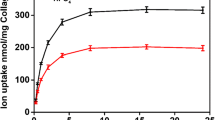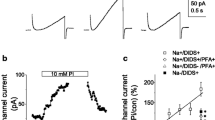Abstract
Macrophages and monocytes secrete a factor(s) which can stimulate the synthesis of collagenase in synovial cells and in chondrocytes. Incubation of rabbit chondrocytes with macrophage conditioned medium (MCM) and with the calcium channel blockers, nifedipine, verapamil or diltiazem (up to 200 μM) had no effect on collagenase synthesis. However, TMB-8 (8-[N, N-diethylamino]-octyl 3,4,5,-trimethoxybenzoate hydrochloride), an inhibitor of internal calcium movement, did inhibit the process with an IC50 of approximately 130 μM. The calmodulin antagonists, trifluoperazine, chlorpromazine and calmidazolium (R-24571) were effective inhibitors of the process with IC50's of 40 μM, 18 μM and 3.5μM, respectively. Collagenase activity itself was not affected by these agents. The data suggests that calmodulin and/or internal calcium movement may play a role in the macrophage factor-stimulated synthesis of collagenase in rabbit chondrocytes.
Similar content being viewed by others
References
J. B. McCarthy, S. M. Wahl, J. C. Rees, C. E. Olsen, A. L. Sandberg and L. M. Wahl,Mediation of macrophage collagenase production by 3′–5′ cyclic adenosine monophosmpate. J. Imm.124 (5), 2405–2409 (1980).
S. M. Wahl and L. M. Wahl,Regulation of macrophage collagenase, prostaglandin, and fibroblast-activating-factor production by antiinflammatory agents: different regulatory mechanisms for tissue injury and repair. Cell. Imm.92, 302–312 (1985).
A. L. Oronsky, R. J. Perper and H. C. Schroder,Phagocytic release and activation of human leukocyte procollagenase. Nature246 (5433), 417–419 (1973).
E. Wojtecka-Lukasik andA. M. Donecewicz, Inhibition of human leukocyte collagenase by some drugs used in the therapy of rheumatic diseases. Biochem. Pharm.23, 2077–2081 (1974).
G. M. Kammer, A. I. Sapolsky and C. J. Malemud,Secretion of an articular cartilage proteoglycan-degrading enzyme activity by murine T lymphocytes in vitro. J. Clin. Invest.76, 395–402 (1985).
J. M. Dayer, R. G. G. Russell and S. M. Krane,Collagenase production by rheumatoid synovial cells, Stimulation by a human lymphocyte factor. Science195, 181–183 (1977).
P. A. McCroskery, S. Arai, E. P. Amento and S. M. Krane,Stimulation of procollagenas synthesis in human rheumatoid synovial fibroblasts by monouclear cell factor/interleukin 1. FEBS Letters191 (1), 7–12 (1985).
C. E. Brinckerhoff, R. M. McMillan, J. M. Dayer and E. D. Harris, Jr.,Inhibition by retinoic acid of collagenase production in rheumatoid synovial cells. New Engl. J. Med.303, 432–436 (1980).
S. C. Ridge, A. L. Oronsky and S. S. Kerwar,Induction of the synthesis of latent collagenase and latent neutral protease in chondrocytes by a factor synthesized by activated macrophages. Arth. Rheum.23, 448–454 (1980).
E. D. Harris, Jr.,Pathogenesis of rheumatoid arthritis. Am. J. Med.80 (Suppl. 4BB), 4–10 (1986).
J. M. Dayer and S. Demcyuk,Cytokines and other mediators in rheumatoid arthritis. Springer Semin. Immunopathol.7, 387–413 (1984).
S. M. Krane and E. P. Amento,Cellular interactions and control of collagenase secretion in the synovium. J. Hheum. Suppl.11, 7–12 (1983).
E. E. Golds, V. Santer, J. Killackey and P. J. Roughley,Mononuclear cell factors stimulate the concomitant secretion of distinct latent proteoglycon, gelatin and collagen degrading enzymes from human skin fibroblasts and synovial cells. J. Rheum.10 (6), 861–871 (1983).
C. Peeters-Joris and G. Vaes,Degradation of cartilage proteoglycan and collagen by synovial cells-stimulation by macrophages under activation by phagocytosis, lymphocyte factors, bacterial products or other inflammatory stimuli. Biochem. Biophys. Acta804, 474–486 (1984).
S. B. Mizel, J. M. Dayer, S. M. Krane and S. E. Mergenhagen,Stimulation of rheumatoid synovial cell collagenase and prostaglandin production by partially purified lymphocyte-activating factor (interleukin-1). Proc. Natl. Acad. Sci. USA78 (4), 2474–2477 (1981).
J. M. Dayer, B. de Rochemonteix, B. Burrus, S. Demczuk and C. A. Dinarello, Human recombinant interleukin 1 stimulates collagenase and prostaglandin E2 production by human synovial cells. J. Clin. Invest.77, 645–648 (1986).
A. E. Postlethwaite, L. B. Lachman, C. L. Mainardi and A. H. Kang,Interleukin 1 stimulation of collagenase production by cultured fibroblasts. J. Exp. Med.157, 801–806 (1983).
H. J. Richardson, P. R. Elford, R. M. Sharrad, J. E. Meats and R. G. G. Russell,Modulation of connective tissue metabolism by partially purified human interleukin 1. Cell Immun.90, 41–51 (1985).
G. DiPasquale, R. Caccese, R. Pasternak, J. Conaty, S. Hubbs and K. Perry,Proteoglycan- and collagen-degrading enzymes from human interleukin-1 stimulated chondrocytes from several species: proteoglycanase and collagenase inhibitors as potentially new disease-modifying antiarthritic agents. Proc. Soc. Exp. Biol. Med.183, 262–267 (1986).
P. Hasselbacher,Stimulation of synovial fibroblasts by calcium oxallate and monosodium urate monohydrate. J. Lab. Clin. Med.100 (6), 977–985 (1982).
C. E. Brinckerhoff, R. M. McMillan, J. V. Fahey and E. D. Harris Jr.,Collagenase production by synovial fibroblasts treated with phorbol myristate acetate. Arthr. Rheum.22, 1109–116 (1979).
L. M. C. Pilsworth, J. Saklatvala,The cartilage-resorbing protein catabolin is made by synovial fibroblasts and its production is increased by phorbol myristate acetate. Biochem. J.216, 481–489 (1983).
J. M. Dayer, M. S. Roelke and S. M. Krane,Effects of prostaglandin E 2,ndomethacin, trifluoperazine and drugs affecting the cytoskeleton on collagenase production by cultured adherent rheumatoid synovial cells. Biochem. Pharm.33 (18), 2893–2899 (1984).
N. Moskowitz, L. Shapiro, W. Schook and S. Puszkin,Phospholipase A 2 modulation by calmodulin, prostaglandins, and cyclic nucleotides. Biochem. Biophys. Res. Commun.115 (1), 94–99 (1983).
J. L. Seltzer, H. G. Welgus, J. J. Jeffrey and A. Z. Eisen,The function of Ca 2+ in the action of mammalian collagenase. Arch. Biochem. Biophys.173, 355–361 (1976).
P. D. Benya, S. R. Padella and M. E. Nimni,The Progeny of rabbit articular chondrocytes synthesize collagen Type I and III and Type I trimer but not Type II. Biochemistry16, 865–872 (1977).
M. T. Gisslow and B. C. McBride,A rapid sensitive collagenase assay. Anal. Biochem.68, 70–78 (1975).
R. J. Smith and S. S. Iden,Phorbol myristate acetate-induced release of granule enzymes from human neutrophils: inhibition by the calcium antagonist, 8-(N, N-diethylamino)-octyl 3,4,5-trimethoxybenzoate hydrochloride. Biochem. Biophys. Res. Commun.91 (1), 263–271 (1979).
A. B. Stavisty, J. R. Dasch and L. Astrachon,Effects of trifluoperazine, a calmodulin antagonist, on rabbit T- and B-cell responses to mitogens and antigen. Cell. Imm.87, 411–423 (1984).
B. Wright, I. Zeidman, R. Greig and G. Poste,Inhibition of macrophage activation by calcium channel blockers and calmodulin antagonists. Cell. Imm.95, 46–53 (1985).
J. C. Nolan and W. C. Pickett,Studies on the effects of cyclo-oxygenase and lipoxygenase inhibitors on the macrophage stimulated synthesis of collagenase by rabbit chondrocytes. Agents Actions17, 73–76 (1985).
J. Aggeler, S. M. Frisch and Z. Werb,Changes in cell shape correlate with collagenase gene expression in rabbit synovial fibroblasts. J. Cell Biol.98, 1662–1671 (1984).
Author information
Authors and Affiliations
Rights and permissions
About this article
Cite this article
Nolan, J.C., Gathright, C.E. & Wagner, L.E. The effect of calcium channel blockers and calmodulin inhibitors on the macrophage factor-stimulated synthesis of collagenase by rabbit chondrocytes. Agents and Actions 25, 71–76 (1988). https://doi.org/10.1007/BF01969097
Received:
Accepted:
Issue Date:
DOI: https://doi.org/10.1007/BF01969097




